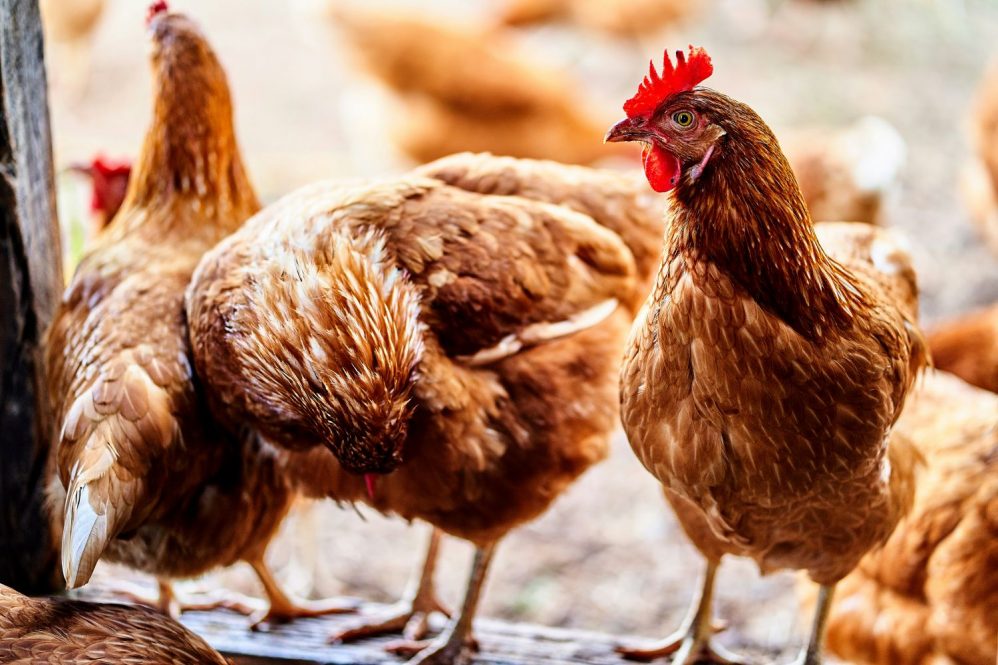UConn researches have demonstrated that a novel protein-based nanoparticle can make mRNA vaccines more effective to tackle a troublesome pathogen in chickens

Henrique S. Ruzzon for Unsplash
Researchers from UConn's College of Agriculture, Health and Natural Resources (CAHNR) and College of Liberal Arts and Sciences (CLAS) have demonstrated that a novel protein-based nanoparticle can make mRNA vaccines more effective to tackle a troublesome pathogen in chickens.
Mazhar Khan, professor in the Department of Pathobiology and Veterinary Science, Challa V. Kumar, emeritus professor in the Department of Chemistry and graduate students Anka Rao Kalluri and Aseno Sakhrie collaborated over several years and published their findings in Vaccines.
Infectious Bronchitis Virus (IBV), a rapidly spreading coronavirus, is a major concern for poultry farmers in the U.S. and worldwide. Poultry farmers lose millions each year due to this disease.
Currently, farmers use live attenuated vaccines or killed vaccines to combat the virus. However, these kinds of vaccine come with a series of challenges. The virus could reactivate, mutate, or recombine to create a vaccine-resistant or more severe strain. These vaccines also have a shorter shelf life and require additional compounds, known as adjuvants, to be effective.
The researchers have developed an effective mRNA IBV vaccine alternative.
mRNA vaccines, like the human COVID-19 vaccines, do not contain any live virus. Instead, the mRNA encodes a piece of the virus' genetic code, specifically the spike protein that is responsible for triggering the immune response and trains the immune system to respond to the protein.
Yet, mRNA vaccines still have some limitations, namely their lack of stability. mRNA vaccines break down quickly and need to be kept in temperature-controlled settings, something that poses a challenge on poultry farms.
In a key advancement, Khan and Sakhrie are using a novel nanoparticle that protects the mRNA from breaking down quickly.
This particle was invented by the Kumar group for applications in biology. It was Kumar who convinced the team to work on mRNA vaccines, long before COVID vaccines arrived. Early hurdles were to efficiently complex the nanoparticles with target mRNA. Kalluri solved this problem by covalently attaching positively charged amine groups to the particle. The positively charged particles capture the negatively charged mRNA and stabilize it. Sakharie and her colleagues carried out detailed cellular and animal studies using these nanoparticle-mRNA complexes.
"This project highlights how collaborations across campus are making rapid progress in solving complex scientific problems," says Kumar.
Amino groups attached to the particle surface not only stabilize the mRNA but also protect it from hydrolysis by nucleases, enzymes that break down the nucleic acids that make up DNA and RNA, in the body.
"The nanoparticle will keep it more stable, and it will deliver the vaccine to the cells where it will express the desired mRNA," Sakhrie says.
The nanoparticles are made by modifying bovine serum albumin, a readily available protein, affordable, and non-toxic protein, a waste product of commercial beef production.
The team's studies have shown that chickens vaccinated with the nanoparticle mRNA vaccine showed a 1000-times increase in antibodies against IBV compared to the unvaccinated control group. Their work has also demonstrated that immune cell activity increased in the vaccinated chickens, which indicates the vaccine boosts the entire immune system to fight off infection.
With these promising results, the researchers are now investigating a more effective vaccination method.
Traditionally, farmers need to individually inject baby chicks with the vaccine, a time-consuming project for the farmers and a stressful one for the chicks.
The team is evaluating if, instead, the vaccine can be administered via a spray on the chicks. This would allow farmers to vaccinate large flocks quickly and without stress to the animals.
While IBV is not currently a concern for human health, using the nanoparticles to enhance the stability of mRNA vaccines has the potential to improve human vaccines. Essentially, researchers could plug the genetic code of an emergent disease into the nanoparticle vaccine platform to quickly develop an effective mRNA vaccine. This platform technology can be tuned to various other disease vectors in the future.
"We can use the nanoparticle for human vaccines," Khan says. "The timing for vaccine development is very short, we just need the specific sequence of the gene."






